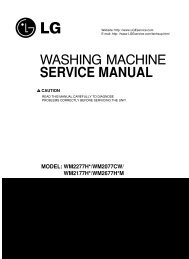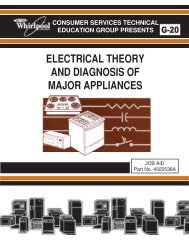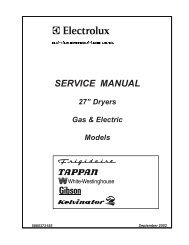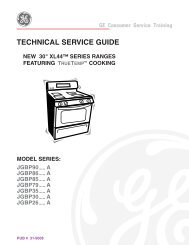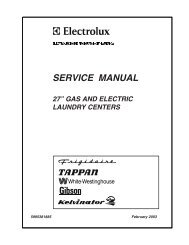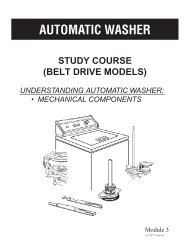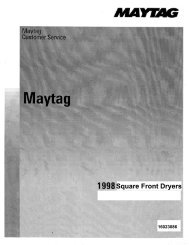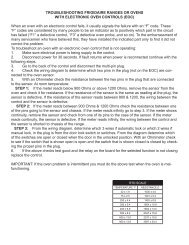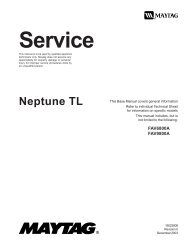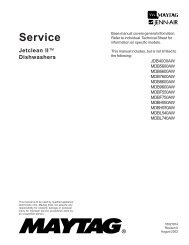MFI2568AES Service Manual - Appliance 911 Sea Breeze
MFI2568AES Service Manual - Appliance 911 Sea Breeze
MFI2568AES Service Manual - Appliance 911 Sea Breeze
You also want an ePaper? Increase the reach of your titles
YUMPU automatically turns print PDFs into web optimized ePapers that Google loves.
<strong>Service</strong> Procedures<br />
! WARNING<br />
To avoid risk of electrical shock, personal injury, or death, disconnect electrical power source to unit, unless test<br />
procedures require power to be connected. Discharge capacitor through a 10,000 ohm resistor before attempting<br />
to service. Ensure all ground wires are connected before certifying unit as repaired and/or operational.<br />
Dehydrating <strong>Sea</strong>led Refrigeration System<br />
Moisture in a refrigerator sealed system exposed to<br />
heat generated by the compressor and motor reacts<br />
chemically with refrigerant and oil in the system and<br />
forms corrosive hydrochloric and hydrofluoric acids.<br />
These acids contribute to breakdown of motor winding<br />
insulation and corrosion of compressor working parts,<br />
causing compressor failure.<br />
In addition, sludge, a residue of the chemical reaction,<br />
coats all surfaces of sealed system, and will eventually<br />
restrict refrigerant flow through capillary tube.<br />
To dehydrate sealed system, evacuate system (see<br />
paragraph Evacuation).<br />
Leak Testing<br />
Testing Systems Containing No Refrigerant Charge<br />
1. Connect cylinder of nitrogen, through gauge<br />
manifold, to process tube of compressor and liquid<br />
line strainer.<br />
2. Open valves on nitrogen cylinder and gauge manifold.<br />
Allow pressure to build within sealed system.<br />
3. Check for leaks using soap suds.<br />
If a leak is detected in a joint, do not to attempt to repair<br />
by applying additional brazing material. Joint must be<br />
disassembled, cleaned and rebrazed. Capture refrigerant<br />
charge (if system is charged), unbraze joint, clean all<br />
parts, then rebraze.<br />
If leak is detected in tubing, replace tubing. If leak is<br />
detected in either coil, replace faulty coil.<br />
!<br />
DANGER<br />
To avoid risk of serious injury or death from violent<br />
explosions, NEVER use oxygen or acetylene for<br />
pressure testing or cleaning out of refrigeration<br />
systems. Free oxygen will explode on contact with<br />
oil. Acetylene will explode spontaneously when put<br />
under pressure.<br />
It is important to check sealed system for refrigerant<br />
leaks. Undetected leaks can lead to repeated service<br />
calls and eventually result in system contamination,<br />
restrictions, and premature compressor failure.<br />
Refrigerant leaks are best detected with halide or<br />
electronic leak detectors.<br />
Testing Systems Containing a Refrigerant Charge<br />
1. Stop unit operation (turn refrigerator off).<br />
2. Holding leak detector exploring tube as close to<br />
system tubing as possible, check all piping, joints,<br />
and fittings.<br />
NOTE: Use soap suds on areas leak detector cannot<br />
reach or reliably test.<br />
12 16026312 ©2006 Maytag <strong>Service</strong>s



